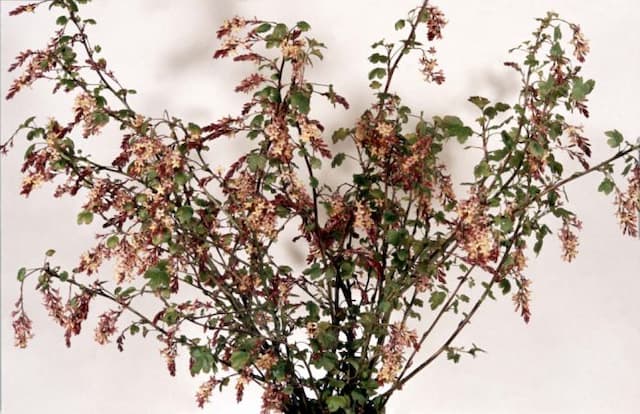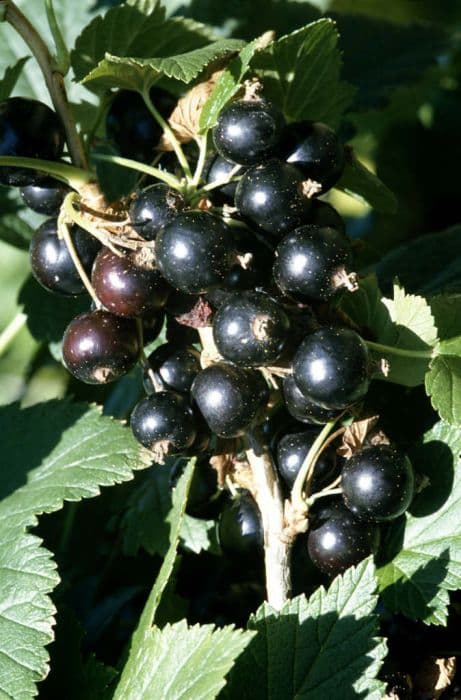Fuchsiaflower Gooseberry Ribes speciosum






ABOUT
The plant known as fuchsia-flowered gooseberry catches the eye with its striking red, fuchsia-like flowers that dangle elegantly from its branches. These tubular blossoms, which are particularly notable for their long, protruding stamens, create a vibrant display against the backdrop of the plant's dark green leaves. The foliage is small to medium-sized, with a glossy finish and a toothed edge that gives them a somewhat spiky appearance. Adding to its distinctive look, the fuchsia-flowered gooseberry is also armed with sharp thorns that line its stems. These thorns, along with its dense, arching growth habit, can create an almost impenetrable barrier, making it a good choice for use in defensive landscaping. In the season following their flowering, the plant produces small, round fruit. The berries start out green but mature to a deep, red-purple color. Although these fruits are edible, they are not typically favored for their flavor, which can be quite tart. The overall visual appeal of the fuchsia-flowered gooseberry, from its showy flowers to its intricate defenses and lush fruit, make it an interesting and attractive addition to gardens where it can grow without size constraints.
About this plant
 Names
NamesFamily
Grossulariaceae.
Synonyms
Fuchsia-Flowered Gooseberry, Flame Flower, Fuchsia-Flower Currant, California Fuchsia.
Common names
Ribes malvaceum, Grossularia speciosa
 Toxicity
ToxicityTo humans
Fuchsia-flowering gooseberry, which is Ribes speciosum, does not have a well-documented history of being toxic to humans. There are no specific toxins in this plant that are known to cause poisoning when ingested. However, as a general precaution, ingesting plants not known to be safe or meant for consumption should be avoided to prevent any possible adverse reactions. If any part of this plant is ingested and symptoms do occur, it would be wise to seek medical advice.
To pets
Fuchsia-flowering gooseberry, or Ribes speciosum, is not commonly listed as a toxic plant to pets. There is no specific information available on toxic components within this plant causing typical symptoms of poisoning in pets such as vomiting, diarrhea, or lethargy. Nonetheless, pets should not be encouraged to eat ornamental plants as they can cause gastrointestinal upset or other unforeseen reactions. If a pet ingests this plant and exhibits signs of distress, contact a veterinarian for guidance.
 Characteristics
CharacteristicsLife cycle
Perennials
Foliage type
Evergreen
Color of leaves
Green
Flower color
Red
Height
3-6 feet (0.9-1.8 meters)
Spread
6 feet (1.8 meters)
Plant type
Shrub
Hardiness zones
7
Native area
California
Benefits
 General Benefits
General Benefits- Attracts wildlife: Ribes speciosum, commonly known as fuchsia-flowered gooseberry, provides nectar and berries that attract birds, butterflies, and other wildlife to the garden.
- Drought tolerance: Once established, the plant has good drought tolerance, making it suitable for xeriscaping and water-efficient gardens.
- Ornamental value: With its attractive, fuchsia-like flowers and vibrant red berries, it adds color and aesthetic appeal to landscapes.
- Erosion control: The dense and spreading habit of fuchsia-flowered gooseberry can help stabilize slopes and prevent soil erosion.
- Native plant gardening: As a plant native to California, it is a good choice for regional gardens and contributes to supporting local ecosystems.
 Medical Properties
Medical PropertiesThis plant is not used for medical purposes.
 Air-purifying Qualities
Air-purifying QualitiesThis plant is not specifically known for air purifying qualities.
 Other Uses
Other Uses- The fruits of the Fuchsia-flowered Gooseberry can be used as a substitute for commercial gooseberries in recipes, although they are not as palatable.
- The dense, spiny branches can serve as a natural barrier or hedge in gardens and landscapes to deter intruders and grazing animals.
- The plant is used for ornamental purposes due to its showy flowers, which can be an attractive addition to floral arrangements.
- The leaves can be used in the creation of dyes, providing a range of colors depending on the mordant used.
- The long-lasting flowers and unusual appearance can be a point of interest in educational gardens, helping to teach about different plant species.
- The wood from mature stems has been used for small woodworking projects, like tool handles, due to its strength and density.
- In permaculture gardens, the Fuchsia-flowered Gooseberry can be planted to support biodiversity, creating habitats for various insects and birds.
- This plant can be used in erosion control efforts on slopes or areas with loose soil, as its root system helps to stabilize the ground.
- The plant's nectar and pollen can serve as food sources for hummingbirds and beneficial insects, integrating it into a pollinator-friendly garden.
- During autumn, the changing foliage can provide aesthetic seasonal color to gardens when other plants have ceased blooming.
Interesting Facts
 Feng Shui
Feng ShuiThe Fuchsia-flowering Gooseberry is not used in Feng Shui practice.
 Zodiac Sign Compitability
Zodiac Sign CompitabilityThe Fuchsia-flowering Gooseberry is not used in astrology practice.
 Plant Symbolism
Plant Symbolism- Resilience: Ribes speciosum, commonly known as Fuchsia-flowered Gooseberry, is a hardy shrub that withstands various conditions, symbolizing the ability to endure and thrive through difficulties.
- Protection: With its spiny branches, the Fuchsia-flowered Gooseberry represents protection and defense against negative forces.
- Attraction: The vibrant red flowers of the Fuchsia-flowered Gooseberry symbolize a powerful attraction and can represent magnetic charm or allure.
 Water
WaterFuchsia-flowering gooseberry prefers deep, infrequent watering to encourage a robust root system, typically needing water every two to three weeks during the active growing season, depending on weather conditions. In cooler coastal areas, this may mean as little as 1 to 2 gallons per plant per month, while hotter inland climates could require up to 4 gallons per month. In winter, when the plant is dormant, watering can be reduced substantially and should only be done to keep the soil from becoming completely dry. Ideally, use drip irrigation or a soaker hose to provide a slow, steady supply at the root zone without wetting the foliage, which helps prevent leaf diseases.
 Light
LightFuchsia-flowering gooseberry thrives in full sun to partial shade. It is best planted in an area where it receives morning sunlight and some afternoon shade, especially in hotter inland areas. Coastal plants can tolerate and even appreciate more direct sun, as the climate is milder.
 Temperature
TemperatureFuchsia-flowering gooseberry is well-suited to a range of temperatures, able to tolerate a minimum temperature of around 20 degrees Fahrenheit and thriving in temperatures up to 90 degrees Fahrenheit. The ideal conditions are between 60 and 75 degrees Fahrenheit, which allows for vigorous growth while not being excessively hot.
 Pruning
PruningPruning fuchsia-flowering gooseberry is necessary to maintain its shape and promote healthy growth. Pruning should be done in late winter or early spring before new growth begins. Remove any dead, damaged, or diseased wood, as well as any crossing branches to improve air circulation. The plant can also be pruned to control its size and encourage the growth of fresh, flowering stems.
 Cleaning
CleaningAs needed
 Soil
SoilFuchsia-flowering gooseberry prefers well-drained soil with a pH of 5.5 to 7.5; a mix of loam, sand, and organic matter like compost works best to provide proper drainage and nutrients.
 Repotting
RepottingFuchsia-flowering gooseberry rarely needs repotting; it is typically repotted once every 2-3 years or when outgrowing its container.
 Humidity & Misting
Humidity & MistingFuchsia-flowering gooseberry tolerates a wide range of humidity conditions but thrives best with moderate humidity levels.
 Suitable locations
Suitable locationsIndoor
Provide bright light, moderate watering, and good air circulation.
Outdoor
Plant in well-drained soil, full sun to partial shade.
Hardiness zone
7-10 USDA
 Life cycle
Life cycleRibes speciosum, commonly known as Fuchsia-flowered Gooseberry, begins its life cycle as a seed, typically undergoing a period of dormancy before germinating in favorable conditions of moisture and temperature. After germination, the seedling emerges, spending its initial growth stage developing a basic root system and foliage. As the plant matures, it enters the vegetative stage, growing stems and leaves in a shrubby form characteristic of the species, and it can take several years to reach reproductive maturity. The reproductive phase is marked by the appearance of striking red flowers resembling fuchsias, usually occurring in late winter to early spring, which are pollinated by hummingbirds and insects. Following pollination, the plant produces small, prickly fruit that contains seeds, completing the reproductive cycle. These berries mature and are eventually dispersed by various means, including animals, which helps to start the next generation of plants.
 Propogation
PropogationPropogation time
Spring to Summer
Propogation: The most popular method of propagating Fuchsia-flowered Gooseberry is through semi-hardwood cuttings. This involves taking a cutting from a healthy parent plant during the late summer or early fall. The cutting should be about 4 to 6 inches long (10 to 15 cm) and include several leaf nodes. The lower leaves are removed, and the cut end is dipped in rooting hormone to encourage root development. The cutting is then inserted into a pot filled with a well-draining soil mix, ensuring at least one or two nodes are buried beneath the soil surface. The pot is kept moist and in a warm location with indirect sunlight. Roots typically develop within a few weeks, after which the new plant can eventually be transplanted outdoors.








